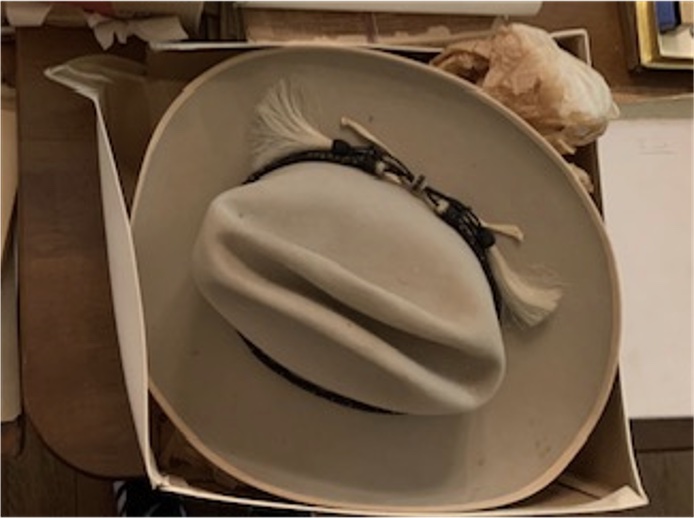Vintage Mallory Hat
FM of Montecito sends me a photo of his grandfather’s vintage Mallory hat, and wonders what became of the venerable custom and manufacture of American fedoras. The story is a sad one in my mind because a handsome man with a hat is irresistible. FM’s hat was made in 1920 by the great American hatmaker Mallory; in this great condition it is worth $75.

Since clothes were worn, headgear was worn, that is, until about 1960, when hats, almost always a statement, became used for outdoor work only. Hats are featured in some of the most iconic images in fine art: Jacques-Louis David’s 1802 portrait of the mounted crusading Napoleon shows the future Emperor wearing a bicorne hat (one of Napoleon’s bicornes just sold at a Paris Auction for $2.1M); Eugene Delacroix’s 1830 Liberty Leading the People shows the bare-breasted French heroine Marianne lofting the Tricolor and sporting a Phrygian cap (since Roman times, associated with liberation from oppression); think of the 50 canvases by René Magritte that feature the Bowler hat of respectability (the Bowler was invented in 1849 by a British nobleman Edward Coke); and remember the Arnolfini Portrait by Jan van Eyck of a nuptial in 1434, a pregnant bride with the homely groom in a huge black hat.
FM’s hat is in a box labeled for Mallory Hat Company, a fedora, and men’s fedoras were invented by Ezra Mallory. The Mallory hatters represent the oldest hat company in the U.S., founded in 1823 by Ezra Mallory in Danbury, Connecticut. Note that Danbury was known as “Hat City” because of the Mallory firm; and the firm is responsible for the colloquial (although some say Lewis Carroll is due this distinction) expression “mad as a hatter.” In fact, so widespread was this neurological disorder amongst hat factory workers that it became known as the “Danbury Shakes’’ or Erethism, caused by the fumes and touch of mercury used in making the felt for hats. The symptoms included slurred speech, tremors, stumbling, and hallucinations. The company made hats for 129 years under one family (all Mallory men but the founder Ezra senior lived to a ripe old age) until it was bought by John B Stetson Co. in 1952.
Ezra (senior) – the most famous U.S. hatter outside of Stetson – was born in Connecticut in 1785; his shop in Danbury’s Great Plain district produced high beaver “stovepipe” hats with bell-shaped crowns and heavily rolled brims. Ezra loaded up his horse with a few dozen hats and rode out to the docks at Norwalk to export his hats to NYC. His hats were made from beaver, muskrat, rabbit, and nutria furs brought to his shop by pelt traders from Russia, Australia, South America, and Scotland.
Ezra’s son Ezra Jr. began making other styles of hats, including caps and soft hats for men, and mechanized the company, installing machines for mixing, blowing, forming, and napping hats. He brought in sewing machines that caused a stir with employees – innovation is always a challenge. Instead of fur traders coming to him, he travelled to Canada and bought furs from the Native American trappers. He didn’t trade in cash until 1850; all trade was barter.
Success came in 1856 with a yearly production of 8,640 hats made by 95 workers with total receipts of $155,000. The onset of the Civil War, however, meant that the lucrative trade with the Southern states stopped, and the company fell into a decline; Ezra picked up hatting jobs in New York, but at the age of 60 returned to Danbury and reopened the business with this son Charles. By 1872 the company was again flourishing, due in part to the new railways that now functioned to unite the East Coast and were used by Mallory travelling salesmen. Another Mallory son and grandson joined the firm, which was incorporated in 1902 under the direction of the octogenarian Ezra: E. A. Mallory and Sons.
Charles was probably the Mallory who was at the helm when FM’s hat was made in 1920; he had taken complete control and turned the shop into a huge factory complex of 21 brick buildings over many city blocks. In 1925, the company’s assets were over $2 million, but American fashionable men went largely bareheaded by the late 1940s; Stetson bought the declining business, and the last Mallory hat was made in July of 1965. I still love a man in a hat, FM; I will look for you wearing that Mallory wide brimmed fedora around town.








You must be logged in to post a comment.